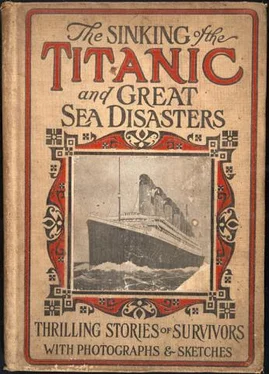Logan Marshall - Sinking of the Titanic and Great Sea Disasters
Здесь есть возможность читать онлайн «Logan Marshall - Sinking of the Titanic and Great Sea Disasters» весь текст электронной книги совершенно бесплатно (целиком полную версию без сокращений). В некоторых случаях можно слушать аудио, скачать через торрент в формате fb2 и присутствует краткое содержание. Год выпуска: 1912, Жанр: Прочая документальная литература, на английском языке. Описание произведения, (предисловие) а так же отзывы посетителей доступны на портале библиотеки ЛибКат.
- Название:Sinking of the Titanic and Great Sea Disasters
- Автор:
- Жанр:
- Год:1912
- ISBN:нет данных
- Рейтинг книги:4.5 / 5. Голосов: 2
-
Избранное:Добавить в избранное
- Отзывы:
-
Ваша оценка:
- 100
- 1
- 2
- 3
- 4
- 5
Sinking of the Titanic and Great Sea Disasters: краткое содержание, описание и аннотация
Предлагаем к чтению аннотацию, описание, краткое содержание или предисловие (зависит от того, что написал сам автор книги «Sinking of the Titanic and Great Sea Disasters»). Если вы не нашли необходимую информацию о книге — напишите в комментариях, мы постараемся отыскать её.
’s demise!
Sinking of the Titanic and Great Sea Disasters — читать онлайн бесплатно полную книгу (весь текст) целиком
Ниже представлен текст книги, разбитый по страницам. Система сохранения места последней прочитанной страницы, позволяет с удобством читать онлайн бесплатно книгу «Sinking of the Titanic and Great Sea Disasters», без необходимости каждый раз заново искать на чём Вы остановились. Поставьте закладку, и сможете в любой момент перейти на страницу, на которой закончили чтение.
Интервал:
Закладка:
The pontoon would follow the line of the ship and seem to be a part of it. The means for releasing it before the sinking of the vessel present no mechanical problem. It would be too large and too buoyant to be sucked down with the wreck.
The pontoon would accommodate, not comfortably but safely, all those who failed to find room in the life-boats.
It is Mr. Nixon’s plan to instal a gas engine in one of the compartments. With this engine the wireless instrument would remain in commission and direct the rescuers after the ship itself had gone down.
Life-preservers are chiefly of the belt or jacket type, made to fit about the body and rendered buoyant by slabs of cork sewed into the garment, or by rubber-lined air-bags. The use of cork is usually considered preferable, as the inflated articles are liable to injury, and jackets are preferable to belts as they can be put on more quickly.
Life-buoys are of several types, but those most common are of the ring type, varying in size from the small one designed to be thrown by hand to the large hollow metal buoy capable of supporting several people. The latter are usually carried by sea-going vessels and are fitted with lamps which are automatically lighted when the buoy is dropped into the water.
American ocean-going steamers are required to have some approved means of firing lines to the shore. Cunningham rockets and the Hunt gun are largely used. The inaccuracy of the rocket is of less importance when fired from a ship than when fired from shore.
CHAPTER XXVIII. TIME FOR REFLECTION AND REFORMS
IT is a long time since any modern vessel of importance has gone down under Nature’s attack, and in general the floating city of steel laughs at the wind and waves. She is not, however, proof against disaster. The danger lies in her own power—in the tens of thousands of horse power with which she may be driven into another ship or into an iceberg standing cold and unyielding as a wall of granite. In view of this fact it is of the utmost importance that present-day vessels should be thoroughly provided with the most efficient life-saving devices. These would seem more important than fireplaces, squash-courts and many other luxuries with which the Titanic was provided. The comparatively few survivors of the ill-fated Titanic were saved by the life-boats. The hundreds of others who went down with the vessel perished because there were no life-boats to carry them until rescue came.
The survivors urge the need of reform. In a resolution drawn up after the disaster they said:
“We feel it our duty to call the attention of the public to what we consider the inadequate supply of life-saving appliances provided for the modern passenger steamships and recommend that immediate steps be taken to compel passenger steamers to carry sufficient boats to accommodate the maximum number of people carried on board. The following facts were observed and should be considered in this connection: The insufficiency of life-boats, rafts, etc.; lack of trained seamen to man same (stokers, stewards, etc., are not efficient boat handlers); not enough officers to carry out emergency orders on the bridge and superintend the launching and control of life-boats; the absence of search lights.
“The Board of Trade allows for entirely too many people in each boat to permit the same to be properly handled. On the Titanic the boat deck was about seventy-five feet from the water and consequently the passengers were required to embark before lowering the boats, thus endangering the operation and preventing the taking on of the maximum number the boats would hold. Boats at all times should be properly equipped with provisions, water, lamps, compasses, lights, etc. Life-saving boat drills should be more frequent and thoroughly carried out and officers should be armed at both drills. There should be greater reduction of speed in fog and ice, as damage if collision actually occurs is liable to be less.
“In conclusion we suggest that an international conference be called to recommend the passage of identical laws providing for the safety of all at sea, and we urge the United States Government to take the initiative as soon as possible.”
That ocean liners take chances with their passengers, though known to the well informed, is newly revealed and comes with a shock of surprise and dismay to most people. If boats are unsinkable as well as fireproof there is no need of any life-boats at all. But no such steamship has ever been constructed.
That it is realized that life-boats may be necessary on the best and newest steamships is proved by the fact that they carry them even beyond the law’s requirements. But if life-boats for one-third of those on the ship are necessary, life-boats for all on board are equally necessary. The law of the United States requires this, but the law and trade regulations of England do not, and these controlled the Titanic and caused the death of over sixteen hundred people.
True, a steamship is rarely crowded to her capacity, and ordinarily accommodations in life-boats for a full list would not be needed. But that is no argument against maximum safety facilities, for when disaster comes it comes unexpectedly, and it might come when every berth was occupied. So there must be life-boats for use in every possible emergency. Places must be found for them and methods for handling them promptly.
Suppose a vessel to be thus equipped, would safety be insured? In calm weather such as the Titanic had, yes, for all that would be needed would be to keep the small boats afloat until help came. The Titanic could have saved everyone aboard. In heavy weather, no. As at present arranged, if a vessel has a list, or, in non-nautical language, has tipped over on one side, only the boats upon the lower side can be dropped, for they must be swung clear of the vessel to be lowered from the davits.
So there is a problem which it is the duty of marine designers to solve. They have heretofore turned their attention to the invention of some new contrivance for comfort and luxury. Now let them grasp the far more important question of taking every soul from a sinking ship. They can do it, and while they are about it, it would be well to supplement life-boats with other methods.
We like to think and to say that nothing is impossible in these days of ceaseless and energetic progress. Certainly it is possible for the brains of marine designers to find a better way for rescue work. Lewis Nixon, ship-builder and designer for years, is sure that we can revolutionize safety appliances. He has had a plan for a long time for the construction of a considerable section of deck that could be detached and floated off like an immense raft. He figures that such a deck-raft could be made to carry the bulk of the passengers.
That may seem a bit chimerical to laymen, but Nixon is no layman. His ideas are worthy of every consideration. Certain it is that something radical must be done, and that the maritime nations must get together, not only in the way of providing more life-saving facilities, but in agreeing upon navigation routes and methods.
Читать дальшеИнтервал:
Закладка:
Похожие книги на «Sinking of the Titanic and Great Sea Disasters»
Представляем Вашему вниманию похожие книги на «Sinking of the Titanic and Great Sea Disasters» списком для выбора. Мы отобрали схожую по названию и смыслу литературу в надежде предоставить читателям больше вариантов отыскать новые, интересные, ещё непрочитанные произведения.
Обсуждение, отзывы о книге «Sinking of the Titanic and Great Sea Disasters» и просто собственные мнения читателей. Оставьте ваши комментарии, напишите, что Вы думаете о произведении, его смысле или главных героях. Укажите что конкретно понравилось, а что нет, и почему Вы так считаете.












